|
New York Architecture Images-New York Architects Warren and Wetmore |
||||
| New York works; | ||||
 |
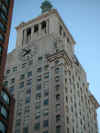
|

|

|
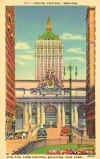 |
| 035 Chelsea Piers | 017 Con Edison Building |
026
Vanderbilt Hotel |
033
Helmsley B |
|
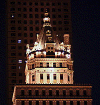
|
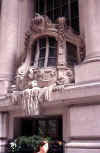 |
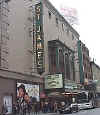 |

|
 |
| 040
Crown Building |
065
New York Yacht Cl |
115
St. James Theater |
009 Down Town Assoc. | 055-927 Fifth Ave. |
|
Whitney Warren (1864–1943) and Charles Wetmore
(1866–1941) first gained prominence as the designer of the New York
Yacht Club (1899–1900) and for their work on Grand Central Terminal
(1903–13, with Reed and Stem). In the early decades of the twentieth
century, Warren and Wetmore received a succession of commissions for
city and country houses from their wealthy friends and relatives.
Beginning in 1910, the firm designed tall hotels in the area around
Grand Central and became increasingly involved in the design of
skyscrapers. The office designed some of the earliest skyscrapers
erected in New York following the passage of the comprehensive zoning
law of 1916. These included the Heckscher Building (1920–21) and the
Aeolian Building (1925–27), both on Fifth Avenue, and the New York
Central Building (1927–29) straddling Park Avenue north of Grand
Central.
WARREN, WHITNEY. (1/29/1864—1/24/1943) New York, N.Y. An architect of prominence in New York from 1896, when he organized the firm of Warren & Wetmore, until his retirement from practice in 1931. Born and educated in New York, at the age of eighteen he went to Paris to study architecture, and while attending Atliers of the Ecole des Beaux Arts, led the life of a cosmopolite, and became so enamored with France that he continued to live there for a decade. In 1896 he returned to New York and formed a partnership with Charles Wetmore under the name Warren & Wetmore. The firm’s bid for recognition in the city was made in submitting plans in a competition for a new home for the New York Club, and having won the competition, the partners embarked on a career which brought fame and notoriety to Whitney Warren. The firm’s first important commission, Grand Central Terminal in New York was followed by Stations on other Railroad Lines, such as the Michigan Central, Canadian Northern and Erie Roads, and in New York a new Office Building for the New York Central, the Chelsea Piers, Steinway Building, and Aeolian Hall. Early in the 1900’s Warren & Wetmore established a reputation in hotel work. Among the firm’s successfully executed designs were the old Belmont, the Ambassador, Ritz Carlton, the Commodore, Vanderbilt, and the Biltmore, all in New York, the Ritz Carlton in Atlantic City, the Belmont, Providence, R.I., Royal Hamilton Hotel in Honolulu, and the Broadmore in Colorado Springs. While all of these were important commissions, Mr. Warren took the most pride in having designed the reconstructed Louvain Library in Belgium, destroyed by the Germans in World War I. The dedication of the building in 1928 led to an international controversy because of Warren’s insistence on an inscription placing on the Germans the guilt of having destroyed the building— “Furore Teutonica Diruta; Dono Americano Restituta” (destroyed by German fury; restored by American generosity). Although Mr. Warren gave up professional
practice in 1931, he was frequently called upon the serve as Consultant
on public projects, and retained his studio in the Beaux Arts Building
on West 44th Street as Office headquarters. A co–founder of the Beaux
Arts Institute of Design and a Director for many years, he remained
active in its affairs, and originated the famous Annual Ball, parties
over which he presided until they were given up in 1937. One of his
chief characteristics was an intense individualism, both in his
professional career and social life. WETMORE, CHARLES D. (1867&151;5/9/1941) New York, N.Y. Formerly a partner of the later Whitney Warren, and under the firm name of Wetmore & Warren established a reputation in designing modern hotel buildings in New York and other cities. Mr. Wetmore was a native of Elmira, N.Y.,
and after attending the city schools completed a formal education at
Harvard, where he was graduated in 1889. During five succeeding years he
studied architecture in New York., subsequently joined Whitney Warren in
partnership. Two of the firm’s major works were the New York Central
R.R. Terminal and the adjoining Biltmore Hotel, while other important
buildings erected from the firm’s plans include the Aeolian Hall, and
the following Hotels: the Ritz Carlton, the Commodore; Ambassador; the
Vanderbilt (1912), and additions to the Plaza Hotel, all in New York.
Warren & also designed the Ritz Carlton in Atlantic city, N.J., the
Belmont in Providence, R.I., the Westchester, Rye, N.Y., the Broadmoore,
Colorado Springs, Colo., and the Royal Hawaiian in Honolulu, completed
in 1937. |
||||
|
links |
www.warrenandwetmore.org | |||